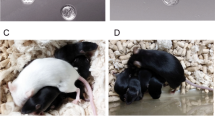Summary
Methods are described for serum-free culture of human epidermal keratinocytes derived from neonatal foreskin tissue. Cultures are initiated, stored frozen, and returned to active growth, all with bovine pituitary extract as the only undefined supplement. Clonal growth assays are then performed in a biochemically defined medium. The degree of stratification and differentiation in the defined medium (and also with pituitary extract) is controlled by the extracellular calcium ion concentration.
Similar content being viewed by others
V. References
Aberer, W.; Stingl, G.; Stingl-Gazze, L. A.; Wolff, K. UV-induced abrogation of the murine Langerhans cell-lymphocyte reaction. (abstract) J. Invest. Dermatol. 76:414; 1981.
Boyce, S. T.; Ham, R. G. Calcium-regulated differentiation of normal human epidermal keratinocytes in chemically defined clonal culture and serum-free serial culture. J. Invest. Dermatol. 81 (1) supplement:33S–40S; 1983.
Boyce, S. T.; Ham, R. G. Normal human epidermal keratinocytes. In: Webber, M.; Sekely, L., eds. In vitro models for cancer research, vol. 3. Boca Raton, Fl: CRC Press; 1985. in press.
Coriell, L. L. Preservation, storage, and shipment. Methods Enzymol. 58:29–36; 1979.
Duvic, M.; Goldsmith, L. A. HLA and skin disease. In: Goldsmith, L. A., ed. Biochemistry and physiology of the skin. New York: Oxford University Press; 1983:951–998.
Freeman, A. E.; Igel, H. J.; Herrman, V. J. et al. Growth and characterization of human epithelial cell cultures. In Vitro 12:352–362; 1976.
Gilchest, B. A.; Calhoun, J.; Maciag, T. Attachment and growth of human keratinocytes in a serum-free environment. J. Cell Physiol. 112:197–206; 1982.
Gilchest, B. A.; Nemore, R. E.; Maciag, T. Growth of human keratinocytes on fibronectin-coated plates. Cell Biol. Int. Rep. 4:1009–1016; 1980.
Green, H. Cyclic AMP in relation to proliferation of the epidermal cell: a new view. Cell 15:801–811; 1978.
Hawley-Nelson, P.; Sullivan, J. E.; Kung, M. et al. Optimized conditions for the growth of human epidermal cells in culture. J. Invest. Dermatol. 75:176–182; 1980.
Hennings, H.; Michael, D.; Cheng, C. et al. Calcium regulation of growth and differentiation of mouse epidermal cells in culture. Cell 19:245–254; 1980.
Huff, J. C.; Norris, D. A.; Cary, M. et al. Study of induction of HLA-DR antigens in human keratinocytes in culture. (abstract) Clin. Res. 32(1):139A; 1984.
Huff, J. C.; Norris, D. A.; Cary, M. G. et al. Induction of HLA-DR antigens in cultured human keratinocytes by stimulated peripheral blood mononuclear cells. (abstract) Clin. Res. 32(2):591A; 1984.
Johnson M.; Roberts, J. Prevalence of dermatological disease among persons 1–74 years of age: United States, Advance Data No. 4, USDHEW; 1977.
LeFeber, W. P.; Norris, D. A.; Ryan, S. R. et al. Ultraviolet light induces binding of antibodies to selected nuclear antigens on cultured human keratinocytes. J. Clin. Invest. 74:1545–1551; 1984.
Liu, S-C.; Karasek, M. A. Isolation and growth of adult human epidermal keratinocytes in culture. J. Invest. Dermatol. 71:157–162; 1978.
Liu, S-C.; Parsons, C. S. Serial cultivation of epidermal keratinocytes from psoriatic plaques. J. Invest. Dermatol. 81:54–61; 1983.
Lowry, O. H.; Rosebrough, N. J.; Farr, A. L. et al. Protein measurement with the Folin phenol reagent. J. Biol. Chem. 193:265–275; 1951.
McKeehan, W. L.; McKeehan, K. A.; Hammond, S. L. et al. Improved medium for clonal growth of human diploid fibroblasts at low concentrations of serum protein. In Vitro 13:399–416; 1977.
Milo, G. E.; Ackerman, G. A.; Noyes, I. Growth and ultrastructural characterization of proliferating human keratinocytes in vitro without added extrinsic factors. In Vitro 16:20–30; 1980.
Morhenn, V. B.; Benike, C. H.; Cox, A. J. et al. Cultured human epidermal keratinocytes do not synthesize HLA-DR. J. Invest. Dermatol. 78:32–37; 1982.
Peehl D.; Ham, R. G. Growth and differentiation of human keratinocytes without a feeder layer or conditioned medium. In Vitro 16:516–525; 1980.
Peehl D.; Ham, R. G. Clonal growth of human keratinocytes with small amounts of dialyzed serum. In Vitro 16:526–540; 1980.
Prunieras, M.; Regnier, M.; Fougere, S. et al. Keratinocytes synthesize basal-lamina proteins in culture. J. Invest. Dermatol. 81(1):74S–81S; 1983.
Rheinwald, J. G.; Beckett, M. A. Defective terminal differentiation in culture as a consistent and selectable character of malignant human keratinocytes. Cell 22:629–632; 1980.
Rheinwald, J. G.; Green, H. Serial cultivation of strains of human epidermal keratinocytes: The formation of keratinizing colonies from single cells. Cell 6:331–334; 1975.
Norris, D. A.; Ryan, S. B.; Kissinger, R. M. et al. Systematic comparison of antibody-mediated mechanisms of keratinocyte lysis in vitro. J. Immunol. 135(2):1073–1079.
Stingl, G.; Stingl-Gazze, L. A.; Aberer, W. et al. Antigen presentation by murine epidermal Langerhans cells and its alteration by ultraviolet B light. J. Immunol. 127:1707–1713; 1981.
Sun, T-T.; Green, H. Differentiation of the epidermal keratinocyte in culture: Formation of the cornified envelope. Cell 9:511–521; 1976.
Tsao M. C.; Walthall, B. J.; Ham, R. G. Clonal growth of normal human epidermal keratinocytes in a defined medium. J. Cell Physiol. 110:219–229; 1982.
Watt, F.; Green, H. Stratification and terminal differentiation of cultured epidermal cells. Nature 295:434–436; 1982.
Wickner, N.; Kissinger, M.; Norris, D. et al. Immunoprecipitation of HLA-DR antigens from gamma interferon-stimulated cultured human keratinocytes. (abstract) J. Invest. Dermatol. 84(4):326; 1985.
Yuspa, S. H.; Harris, C. C. Altered differentiation of mouse epidermal cells treated with retinyl acetate in vitro. Exp. Cell Res. 86:95–105; 1974.
Yuspa, S. H.; Hawley-Nelson, P.; Kochler, B. et al. A survey of transformation markers in differentiating epidermal cell lines in culture. Cancer Res. 40:4694–4703; 1980.
Author information
Authors and Affiliations
Rights and permissions
About this article
Cite this article
Boyce, S.T., Ham, R.G. Cultivation, frozen storage, and clonal growth of normal human epidermal keratinocytes in serum-free media. Journal of Tissue Culture Methods 9, 83–93 (1985). https://doi.org/10.1007/BF01797779
Issue Date:
DOI: https://doi.org/10.1007/BF01797779




